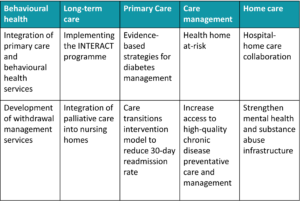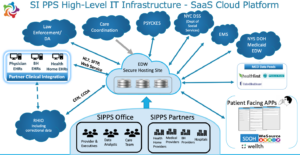Virtual wards are failing patients and clinicians: we must bridge the gaps before winter

With virtual wards vital to the NHS’s ability to function this winter, three experts assess what is needed to bridge the gaps in provision ahead of increased demand.
In early August, NHS England unveiled its new plan to increase the NHS’s capacity and resilience ahead of winter’s inevitable pressures. An increased use of virtual wards featured prominently in this plan, in line with their national target of 25,000 virtual beds to be operational by 2023.
With hospitals overwhelmed like never before, it’s not hard to understand why transferring patient care into the home – in a safe and controlled way – is an extremely beneficial proposition. But existing solutions are missing the mark. Despite much innovation, delays in adoption mean that the full transformative potential of the tech-enabled hospital at home has not yet been realised. We are now at a tipping point: on the heels of a global pandemic and one of the busiest summers yet, a tough winter is looming. It is time to get virtual wards right; for patients, for healthcare professionals and for the NHS.
Existing solutions don’t go far enough
‘Virtual wards’ are not new and versions of the concept – including ‘Hospital at Home’ – are already being used to support unwell and deteriorating patients to stay at home, as well as to discharge patients from hospital sooner.
What is generally considered to be a virtual ward often extends to little more than remote monitoring at home. While this does free up hospital beds, the impact on both clinical time saving and patient outcomes falls well short of potential.
This is because, overwhelmingly, staff must use old, inappropriate tools to manage remote patients – tools that weren’t built for this new paradigm. Many approaches are manual, slow, admin-intensive, and not advanced enough to scale.
New ways of working need new solutions
Remote care requires an entirely different way of working, and needs new technologies to manage it and make it scalable. Right now, communication and the flow of critical information is blocked. Electronic task lists and care coordination features are not flexible enough to fulfil the unique needs of virtual wards, where patients are not co-located with healthcare staff. Integration is near non-existent, and workflows are not built for mobile access, nor do they allow tasks to be allocated and tracked in real-time.
We must go further for patients or clinicians. A true virtual ward solution can do more – should do more – to protect patients and make clinicians’ jobs more manageable.
Creating a true virtual ward
If virtual wards are to be done correctly, and their potential fully realised, innovation and action must focus on six areas:
1. The right information at the right time
For virtual wards to save valuable clinical time and ensure high quality care, data generated in patients’ homes must be of equivalent quality to that captured in hospital. It should also be distilled into actionable insights to save clinicians from filtering large amounts of data. And here lies the problem.
The 2019 Topol Review emphasised that large volumes of unfiltered data can be immensely overwhelming for an already overworked workforce. We know that conventional remote monitoring generates noisy data that wastes clinical time and can mislead clinical assessments, introducing risk.
To overcome this, advanced tools are needed, such as those utilising AI, to take on the time-consuming task of reviewing millions of data points to ensure quality and translate data into insights.
2. Seamless patient engagement
Patient engagement tools must be a core component of virtual wards, ensuring patients have a positive experience and feel confident that they can contact the clinical team if they need.
Good patient engagement provides a seamless experience whether a patient is co-located with clinicians in an acute hospital setting, or in the community.
Patients should receive ad hoc or scheduled contact via a method that suits them. This could be a digital assessment form sent to the patient, providing a low cost but highly effective method that complements data gathered from remote monitoring devices.
Patients should also be able to easily request a phone, video, or in-person appointment at a time that suits them.
In combination with care coordination and remote monitoring tools, effective patient communications are a powerful way to keep patients safe and them and their families reassured.
3. Proactive rather than reactive management of health
Moving from reactive to proactive management of patients’ health means two things for virtual wards:
Firstly, care must be targeted to patients pre-admission to hospital instead of post-discharge. This means initiating virtual care in the community to minimise the risk of admission, especially for ambulatory care sensitive conditions. More importantly, when it comes to avoidable admissions to hospital and frail patients, this could prevent a deterioration in their condition, which could happen off the back of a hospitalisation and could cost them their independence.
Secondly, mechanisms must be in place for early detection of deterioration. Therefore, being able to identify early signs and intervene before complications and readmissions to hospital become inevitable.
4. Health equity by design
The pandemic has revealed the multi-layered inequities that impact healthcare access and healthcare outcomes. One way in which virtual wards must address these is by investing in scalable community workforce models – that include healthcare assistants – to support care delivery to patients who cannot self-administer.
A second way to promote equity is by ensuring that no one is digitally excluded due to, for example, poor WiFi connectivity or lack of digital confidence or capability. Equally important is to look beyond physical symptoms to integrate social determinants of health into the modelling, planning and delivery of virtual wards.
5. Effective skill-mixing and empowerment
Enabling a diverse network of multidisciplinary staff to participate in the delivery of virtual wards is critical to resourcing these new models of care without adding to doctors’ and nurses’ workloads.
From healthcare assistants, to patients, to their friends and family members, different stakeholders should be empowered to fuel a proactive model of care at home. This includes training, decision-support tools and streamlined workflow management – and requires tools to handover and assign the right tasks to the right healthcare professionals – to cover the effective identification and appropriate escalation of health issues.
6. Effective task management
The best outcomes from virtual wards will result from multidisciplinary staff having secure access to a shared list of patients and the tasks that need to be done for them. They should be able to review the list in virtual ward rounds or whenever required, add and allocate tasks, and mark them as accepted, in-progress, or completed for colleagues to see or track. The entire team ought to have visibility and be able to collaborate and coordinate care remotely, ensuring caseload management is efficient and safe.
Automated workflows can make it easy for staff to identify where readings from intelligent remote monitoring devices fall outside of set ranges, supporting safer and more effective clinical decision-making.
Enabling a new era of care delivery
At this moment, NHS organisations have a unique opportunity to begin the virtual wards roll out on the strongest possible footing, with the best solutions in place. A focus on the six pillars that encompass care coordination, patient communication and remote monitoring, will accelerate a successful transition to a new era for care delivery, and help establish virtual wards as a credible, scalable alternative to acute hospital admissions.
Elliott Engers is CEO at Infinity Health.
Tom Whicher is CEO at DrDoctor.
Elina Naydenova is CEO at Feebris.












